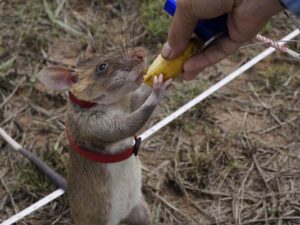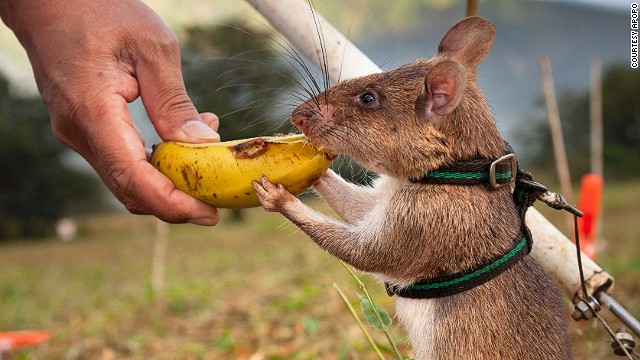Cricetomys gambianus is the scientific name of the Gambian pouched rat, also known as the African giant pouched rat. The Cricetomys-part of its scientific name is because these animals have hamster-pouches in their cheeks [Cricetomys = Criceta = Hamster], where they can hide and transport food. Anyway, the Gambian pouched rat is not a hamster. Actually, it is not even a rat: in fact, it belongs to an African family of muroid rodents.
Anyhow… these animals look like rats. (To be more accurate, the Rattus Norvegicus.)
In the last years, scientists have been discovered that they are really valuable animals. Why? This “rat” has a weak sight, but on the contrary has a very good hearing and above all an excellent sense of smell. These natural features, together with its smartness and its mild character, make it suitable to become an excellent land mines detector. Yes, you read it right! Since 2006, these rats have been helping in demining more than 11 million square meters of land in Mozambique (but even in Tanzania, Angola and Cambodia), finding more than 13.000 mines: the African giant has proved to be faster than humans with metal detectors. This because animals detect only mines, through the identification of the mix of the smell of metal and gunpowder (of which mines are made of), while a metal detector detects ALL metal residues, slowing sharply the work of remediation of the soil. Even if it is easier to think about the dog as men’s helper, rats are the best choice: they are less expensive to train than dogs ($7.300 against $25.000 for a nine-month training) and provide a totally danger-free service. Indeed, the maximum weight they reach is largely lower than the one needed to trigger the mine. Otherwise, for a medium-sized dog it is a risk to venture in a minefield.
 Rats are linked to a fixed rope, and move along paths defined by the trainers. After each step, the rope is shifted by half a meter, to follow a grid and to secure the zone, in order to carefully scouring the entirety of the areas to be reclaimed. When a rodent finds a mine, it begins to scratch the ground, and then his coach calls him back with a pre-established sound and gives him a prize: a blend of banana, peanut butter and nuts. A treat for the taste buds of the rat…
Rats are linked to a fixed rope, and move along paths defined by the trainers. After each step, the rope is shifted by half a meter, to follow a grid and to secure the zone, in order to carefully scouring the entirety of the areas to be reclaimed. When a rodent finds a mine, it begins to scratch the ground, and then his coach calls him back with a pre-established sound and gives him a prize: a blend of banana, peanut butter and nuts. A treat for the taste buds of the rat…
Nevertheless, the flair of these giant rats is not used only for the demining of the former battlefields…
Recently, it has been found that the smell of the Gambian pouched rat can be used for the recognition of the TB bacteria in the saliva of infected patients. Human samples are sent to the research laboratories, where are thermally treated to destroy pathogens, then the test to detect the disease starts: if it results negative, the sample goes to the trained rats: if two rats identify a problem with it, it is sent back to the laboratory for a re-examination. According to data of an African laboratory that employs rats, 7.000 are the cases of TB not revealed by conventional tests, but identified by rats: thus, 24.000 are the potential infections arrested by our giant friends. Currently, researchers are interested in discovering if these rats could be used in sniffing out cancer: surely, they are more helpful in this way, rather than torn apart after being subject to sadistic and unnecessary tortures. (Learn more: https://www.oipa.org/international/vivisection/)
And last but not the least… COPS RATS. Oh yes, this really sounds like a joke, but I swear I did not invented it! Even in this case, for their fine sense of smell, the aim (not yet reached) is to use them, within a year, to flush out illegal shipments of precious wood and protected animals, in particular the extremely endangered pangolin, destined for Asian illicit markets. (See: https://www.oipa.org/international/exotic-animals/) Smaller and more agile than dogs, African giant rats would be able to sneak into ships’ containers ready to set sail for China, from the port of Dar es Salaam, to check that the load carried respects the International agreements and the life of all the sentient living beings. If this experiment will be successful, it will result almost certainly in new teaching for the rats: to find elephant tusks and rhino horns. (https://www.oipa.org/international/tanzania-elephants/ and https://www.oipa.org/international/swaziland-rhino-horn/).
We obviously have to remember that these rats are sentient living beings, too. We cannot expect they will happily help us if we treated them as refuses. First, we have to remember that we are employing them to repair what human beings have fabricated and contrived: from minefields up to poaching, things whose goal are the destruction of the rest of creation. Therefore, it is fundamental to ensure compliance with the ethological needs of the animals involved. No results, even a turning point, will worth the loss of our humanity: if we find a cure for the worst disease of the world, but we sacrifice all the animals of the earth, we will find the cure for a heartless humankind. And there is no cure for a cold, heartless body. To have respect, we must first grant it to the others. Even if the others are “only” rats.
Author
Paola Colombo




